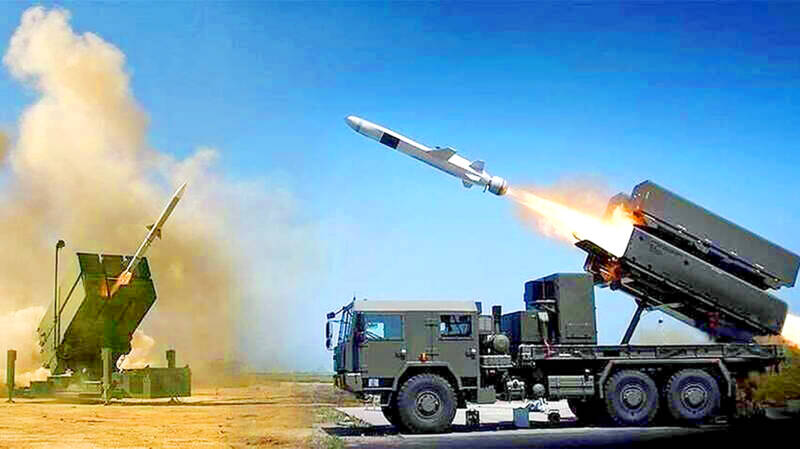The Norwegian Advanced Surface-to-Air Missile Systems (NASAMS) Taiwan ordered from the US would be installed in strategically important positions in Taipei and New Taipei City to guard the region, the Ministry of National Defense said in statement yesterday.
The air defense system would be deployed in Taipei’s Songshan District (松山) and New Taipei City’s Tamsui District (淡水), the ministry said, adding that the systems could be delivered as soon as the end of this year.
The US Defense Security Cooperation Agency has previously said that three NASAMS would be sold to Taiwan.

Photo: Screen grab from the Kongsberg Defence and Aerospace Web site
The weapons are part of the 17th US arms sale to Taiwan during the administration of US President Joe Biden.
The system is designed for the ground-launched version of the US-made AIM-120 Advanced Medium-Range Air-to-Air Missiles (AMRAAM) and AIM-9X Sidewinder missiles, as well as Europe’s jointly developed IRIS-T SLS short-range missiles.
NASAMS are compatible with the AN/MPQ-64 Sentinel radar system and use Link-16 tactical data link technology.
The AMRAAM-ER, the extended-range variant of the AIM-120, is capable of intercepting aircraft and supersonic cruise missiles. It has a range of about 50km.
NASAMS would give medium-altitude capability to supplement Taiwan’s other air defense systems, including the land-based variant of the Tien Chien II (Sky Sword II) and Tien Kung (Sky Bow) families of missiles, as well as the Patriot Advanced Capability-3 (PAC-3).
The Tien Chien II is a mobile air defense system designed to protect ground forces with a range of 15km, while the Tien Kung family have a maximum interception altitude of 45km. The PAC-3 has a maximum interception altitude of 24km.
The ministry also announced two other weapons procurements contracts — one for L-band electronic radar arrays and another for non-L-band electronic radar arrays, as well as four logistics and sustainment contracts for several systems.
The radar contracts are likely to be for AN/TPS-77 and AN/TPS-78 forward warning systems.
The NASAMS and radar array contracts have a listed allocation of NT$24.3 billion (US$737.17 million) and are to be implemented by February 2034 and March 2030 respectively.
The air force’s 793rd Air Defense Brigade would receive spare parts for air defense missiles and support for PAC-3 systems in two contracts allocated a combined NT$2.33 billion.
The former contract is to be implemented by 2028 and the latter by 2029.
The Tainan-based 1st Tactical Fighter Wing and the Pingtung-based 6th Tactical Fighter Wing would receive a NT$6.4 billion budget to ship components to the US for maintenance and support. The program is to be implemented through December 2030.
The ministry awarded Montreal-based CAE Inc a NT$79 million contract for the maintenance and repair of flight simulators for Lockheed C-130 Hercules transport aircraft and Lockheed P-3 Orion antisubmarine warfare aircraft.
The contract would be implemented through 2029.
Defense expert Mei Fu-hsing (梅復興) said that the NASAMS proved to be a highly effective weapon in Ukraine’s air defense strategy amid its war with Russia, while Washington has long recommended Taiwan to acquire it as a key asymmetric warfare capability.
The Norwegian air defense weapons are one of the few truly asymmetric systems Taiwan has bought in the past few years, Mei said.
Additional reporting by Chen Chih-chen

TRAGEDY STRIKES TAIPEI: The suspect died after falling off a building after he threw smoke grenades into Taipei Main Station and went on a killing spree in Zhongshan A 27-year-old suspect allegedly threw smoke grenades in Taipei Main Station and then proceeded to Zhongshan MRT Station in a random killing spree that resulted in the death of the suspect and two other civilians, and seven injured, including one in critical condition, as of press time last night. The suspect, identified as a man surnamed Chang Wen (張文), allegedly began the attack at Taipei Main Station, the Taipei Fire Department said, adding that it received a report at 5:24pm that smoke grenades had been thrown in the station. One man in his 50s was rushed to hospital after a cardiac arrest

A car bomb killed a senior Russian general in southern Moscow yesterday morning, the latest high-profile army figure to be blown up in a blast that came just hours after Russian and Ukrainian delegates held separate talks in Miami on a plan to end the war. Kyiv has not commented on the incident, but Russian investigators said they were probing whether the blast was “linked” to “Ukrainian special forces.” The attack was similar to other assassinations of generals and pro-war figures that have either been claimed, or are widely believed to have been orchestrated, by Ukraine. Russian Lieutenant General Fanil Sarvarov, 56, head

SAFETY FIRST: Double the number of police were deployed at the Taipei Marathon, while other cities released plans to bolster public event safety Authorities across Taiwan have stepped up security measures ahead of Christmas and New Year events, following a knife and smoke bomb attack in Taipei on Friday that left four people dead and 11 injured. In a bid to prevent potential copycat incidents, police deployments have been expanded for large gatherings, transport hubs, and other crowded public spaces, according to official statements from police and city authorities. Taipei Mayor Chiang Wan-an (蔣萬安) said the city has “comprehensively raised security readiness” in crowded areas, increased police deployments with armed officers, and intensified patrols during weekends and nighttime hours. For large-scale events, security checkpoints and explosives

PUBLIC SAFETY: The premier said that security would be tightened in transport hubs, while President Lai commended the public for their bravery The government is to deploy more police, including rapid response units, in crowded public areas to ensure a swift response to any threats, President William Lai (賴清德) said yesterday after a knife attack killed three people and injured 11 in Taipei the previous day. Lai made the remarks following a briefing by the National Police Agency on the progress of the investigation, saying that the attack underscored the importance of cooperation in public security between the central and local governments. The attack unfolded in the early evening on Friday around Taipei Main Station’s M7 exit and later near the Taipei MRT’s Zhongshan